For virtually all of human history, the species has been land-bound, genetically coded to think and act with feet planted firmly on solid ground. Then, in December 1903, two bicycle-makers from Ohio expanded the human paradigm for all time when they left the Earth and entered the vertical dimension.
Yet initially, even Orville and Wilbur Wright remained unidirectional in their thinking—and flying. The earliest Wright aircraft flew only straight ahead. It was not until the fall of 1904 that the first aerial turns were routinely attempted.
During the first decade of manned and powered flight—although it was possible to maneuver in a three-dimensional sky—actually engaging and destroying another maneuvering aircraft in the air remained nearly impossible for pilots and gunners.
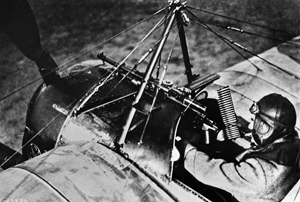 |
Roland Garros at the controls of his Morane-Saulnier, which included metal deflectors on the propeller. (Photos courtesy of the National Air and Space Museum, Smithsonian Institution) |
Perhaps this explains why the earliest attempts to use cloth, wood, and wire aeroplanes as weapons were linked directly to the Earth. The ground was easily viewed and observed, and so World War I aircraft were first used to observe enemy troop movements and concentrations, then to direct artillery fire against enemy targets, and finally to strafe and bomb the battlefield.
Initially, opposing pilots carried out their missions without interfering with their adversary’s objectives—sometimes even acknowledging each other in passing with a chivalrous air-to-air salute. Soon, the reality of effectively aimed artillery fire and resultant casualties to friendly forces ended the bonhomie between enemy aviators.
Early, feeble attempts to fight back against aerial onslaughts were seldom successful. From the ground, trying to hit a small target unpredictably flying above the combat zone was like a duck hunter armed with a BB gun trying to shoot a mallard maneuvering wildly so as to avoid being struck.
Hitting an airplane that flew straight and level was easier, but still a huge challenge. A better method was needed to shoot down enemy aircraft before they could reconnoiter or attack friendly positions. During those days, only another “aeroplane” could intercept and destroy an adversary aircraft before it reached the combat zone.
Such attacks on enemy aircraft were often clumsy and futile, but there were some early successes.
A few pilots were able to force their adversary to the ground simply by intimidation. The assailant flew so close to the enemy airplane that, fearing a midair collision, the enemy crash-landed to avoid uncontrolled certain death.
Logically, either for defense against attacks or for the purpose of offensive action, pilots began carrying weapons on board their airplanes. A variety of pistols and rifles, grenades, even grappling devices were used to attack those attempting to determine the location of, or direct attacks on, troops or supplies.
Machine Guns
Less than three months after World War I began in August 1914, the first aerial victory was scored by a two-seat French Voisin III pusher-type biplane against a German Aviatik B.1 biplane.
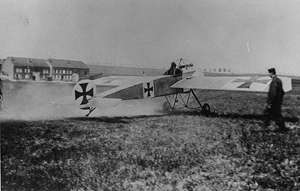 |
A Fokker Eindecker E.I, which many consider to be the world’s first true fighter aircraft, taxis on a rough landing strip. (Photos courtesy of the National Air and Space Museum, Smithsonian Institution) |
The aerial victory resulted after the French gunner fired his Hotchkiss machine gun into the paralyzed Aviatik, igniting the flammable craft which then crashed in a ball of fire, killing the crew. Airmen wore no parachutes in these early days and always went down with their ship.
As the invention of the machine gun would mold the battlefields of Europe into a network of trenches and underground bunkers, so too did the machine gun shape the conduct of the air war above the blood and muck below.
By spring 1915, although there had been some success at shooting down enemy aircraft with hand-fired weapons, the performance of early aircraft was drastically reduced when additional crewmen were required to fire such weapons. Early duels between crew-type aircraft were frequently two-dimensional because the craft had limited capability to maneuver without stalling and falling out of the sky.
The resultant attacks were fought more like heroic naval battles at Trafalgar—one broadside after another—while the airplanes flew in level, nonmaneuvering flight.
Improvements in engine power and maneuverability quickly complicated the survival equation for lumbering craft. Yet even superior speed and maneuverability did not solve the inherent problem of striking another flying craft with bullets in midair.
Pursuit aircraft that were flown with only the pilot aboard created an entirely new set of problems. Even though the reduced weight improved performance, operating the weapon while flying the airplane into a position to attack an enemy was often dangerous.
A variety of gun placement solutions had been attempted: on top of the wing, angled from the fuselage slightly outward to miss the propeller, as well as inside the cockpit, and none was completely efficient or routinely successful.
There remained two significant issues to resolve.
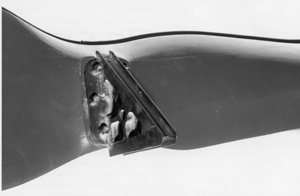 |
Right, a close-up of the bullet deflector. (Photos courtesy of the National Air and Space Museum, Smithsonian Institution) |
First, and most problematic, was how to target an enemy from a moving airplane without the ability to determine with any certainty at least one specific geometric plane of motion. Man’s inability to understand and immediately react to the complexity of intertwined three-dimensional aerial battles without some kind of fixed plane of reference made any successful attack much more a stroke of coincidence than aerial skill.
Second, the technical reliability of the aerial machine gun required that the pilot have easy access to the firing and loading mechanisms to deal with the inevitable jamming or failure of the gun. At least one hapless aviator was tossed unceremoniously from his airplane while attempting to reload or repair an over-wing mounted machine gun.
The solution seemed simple: to locate the machine gun within the pilot’s reach for loading and repairing while still offering an easy method of aiming at the enemy airplane. For an aircraft powered by a rear-mounted propeller, the weight of the gun located in the nose of the airplane displaced the craft’s center of gravity, making control extremely difficult.
For the majority of aircraft, powered with front-mounted “tractor” propulsion systems, the propeller remained an impenetrable barrier to engaging the enemy.
Although prewar work had been done on the concept of firing a machine gun through the arc of an airplane propeller, including at least two patents for such a “synchronizer mechanism,” no system had been perfected. This included one such mechanism designed and built by Raymond Saulnier, co-owner with Leon Morane of a newly established French aviation company.
Morane-Saulnier built a high-performance monoplane, unusual for that time, in which a young Frenchman named Roland Garros (who was taught to fly by the legendary Brazilian Alberto Santos-Dumont) crossed the Mediterranean Sea—a first for an aeroplane. As war erupted, Garros was flying Morane monoplanes in a French aerial squadron.
During a meeting between Garros and Saulnier in Paris during the first bleak winter of the Great War, they discussed the development of the synchronized aerial machine gun. It seemed that Saulnier’s firing regulator worked perfectly but it was the imperfections inherent in firing the machine gun itself that yielded less than desirable results. Inconsistencies in projectile shape and quantity and quality of gunpowder charges resulted in inconsistent firing sequences.
Shooting Through the Arc
Sometimes the variances were so great that the bullets struck the propellers and splintered them like dry twigs.
Garros—who took military leave to be a test pilot for Saulnier until March 1915—had recognized early during his wartime military flying that a fixed forward-firing machine gun was the best way to eliminate some of the variables inherent in multidimensional aerial combat. At least one axis of motion needed to be stable or controllable.
A fixed forward-firing gun could provide a relatively predictable firing plane of motion. The propensity to wreck propellers, however, was a weakness that could not be tolerated. Knowing this, Saulnier attempted to protect the prop—literally. He affixed to its surface metal wedges that acted to deflect bullets fired into the prop.
Garros’ mechanic, Jules Hue, had bolstered the deflectors, which had failed catastrophically in a test flight. After these improvements, Garros felt confident enough to attempt combat in the newly modified Morane-Saulnier Type L Parasol monoplane.
On April 1, 1915, Garros successfully attacked and shot down a German biplane south of Dixmude, near Dunkirk. He approached from the rear and fired his Hotchkiss gun through the propeller’s arc until the enemy airplane was destroyed. Garros tallied two more gun kills over the next few weeks, but on April 18 was forced to crash-land in enemy territory after his Morane was hit by ground fire during a low-altitude surface attack, rupturing his fuel line.
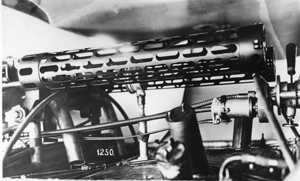 |
The synchronizer from a Fokker D-VII. German designer Anthony Fokker perfected the synchronizing system that Roland Garros had begun. (Photos courtesy of the National Air and Space Museum, Smithsonian Institution) |
This “golden BB” killed the engine and brought down the airplane, and Garros spent the next three years as a prisoner of war.
German technicians captured the gun and the propeller, which still had the metal deflectors installed, and made several tests of the system. Even with access to Garros’ previously functioning gun and deflector set, however, they could not get the system to work properly.
German machine gun muzzle velocities were somewhat greater than those of the French Hotchkiss gun, and when the big German steel-coated bullets were fired into the propeller arc—even one protected by metal deflectors—the power of the weapon fractured the prop.
The tests demonstrated conclusively that, if a pilot were going to fire through a propeller, it was essential that the bullet not strike the propeller at all.
It took little time for German designer Anthony Fokker, a Dutchman by birth, to perfect the system that Garros had begun. Fokker’s team likely used information from a 1913 synchronizer mechanism patented by Swiss engineer Franz Schneider, to bring the invention to practicality.
They designed a cam wheel to regulate the precise times when the gun could fire. This cam was attached to the same shaft that rotated the propeller and enabled the firing mechanism at precise moments when the known location of the propeller blade could easily be avoided.
Fokker selected the German Parabellum machine gun and fitted it to an airplane of his own design—the Eindecker (meaning “one-decker” or monoplane). The Fokker E.I/15 (military designation) then became the first practical fighter aircraft in history.
The synchronizer, which eliminated the need for deflectors, immediately provided a nearly insurmountable advantage for German pilots such as Max Immelmann and Oswald Boelcke, who also enjoyed improved engine performance found in the follow-on Eindecker E.II and E.III aircraft.
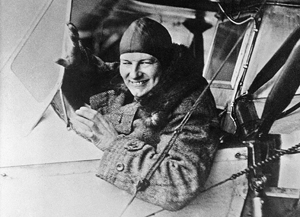 |
Dutch-born German airplane designer Fokker at the controls of one of his biplanes. (Photos courtesy of the National Air and Space Museum,Smithsonian Institution) |
The “X” and “Y” Axis
Immelmann is officially credited with scoring the first victory with the Fokker synchronizer gear on Aug. 1, 1915. Even so, there remain unconfirmed claims that another German pilot, Lt. Kurt Wintgens, shot down a Morane-Saulnier Type L, like the one Garros had flown, in July.
Regardless of who actually scored that first kill, the essential firing problem had been solved. These early victories marked the beginning of almost a year of German air dominance that came to be known as “the Fokker Scourge,” as Germany alone had the advantage of firing forward, directly through the arc of the airplane’s propeller.
Not until the Allies could develop their own synchronizer mechanism would they pose a serious threat to German pilots such as Boelcke, Immelmann, and the most famous of all, Manfred von Richthofen—the “Red Baron.”
The development of the fixed forward-firing aerial machine gun was a natural attempt to approximate man’s two-dimensional nature—a comfortable “X and Y axis” world easily understood and manipulated. Since the Fokker Eindecker’s introduction, most fighter aircraft have sported fixed forward-firing guns.
The solution to firing through the arc became moot—actually, obsolete—with the invention of turbine-powered jet fighters.
With the introduction of lead-computing gunsights and radar, which successfully quantified one of the most difficult variables in aerial combat—distance to target—the fixed forward-firing gun has remained the seldom used close-in weapon of choice for fighter pilots. Yet, even today’s head-up display and avionics solutions do little to truly immerse modern aviators in the actual three-dimensional world.
Flat HUD screens and “steer to fire” technology used in modern fighters essentially relieve pilots from envisioning three-dimensional combat and instead place them squarely into a two-dimensional environment. Even while flying a highly maneuverable airplane in three dimensions, the preponderance of piloting remains based on two-dimensional inputs rather than three-dimensional spatial orientation cues.
This, after all, was the basic idea behind firing through the arc in the first place.
Dik A. Daso, a retired Air Force RF-4 and F-15 pilot and T-38 instructor, is the curator of modern military aircraft at the Smithsonian’s National Air and Space Museum. His most recent book, US Air Force: A Complete History, was published last year. This is his first article for Air Force Magazine.